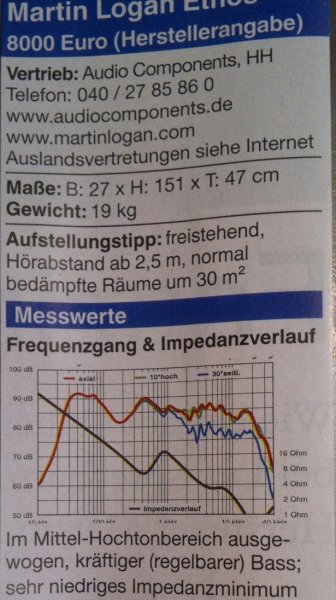I have the opportunity to purchase a pair of VTL Siegfried Series Is. I presently have VTL MB-750s, and I anticipate getting MartinLogan Neoliths in the future.
I am considering the Siegfrieds to passively, horizontally bi-amp the future Neoliths.
My view is that there pretty much is no such thing as too much power on big MartinLogan hybrid speakers. The MB-750s and the Siegfrieds should output approximately the same power.
If I wanted more low-frequency oomph or I wanted some flexibility to tinker with the frequency response of the system in my room from 23 to 400 Hz the Siegfrieds would afford me the option to experiment with driving the panels with my current MB-750s in triode mode and driving the woofers and subwoofers with the Siegfrieds in tetrode mode (twice the power of triode mode).
If I needed to tinker with the frequency response of the Neoliths from 23 to 400 Hz, with the Siegfrieds in tetrode mode I could boost both the 15" driver (covering 23 hz to 60 hz) and the 12" driver (covering 60hz to 250-400 hz (based on crossover setting)) by 3 dB, or I could boost only the 12" driver by 3dB and keep the 15" driver the same (by switching in the built-in 4 dB attenuator for the 15" driver).
For those who object to passive bi-amping — I totally understand. If MartinLogan follows its past practice it will release an active-crossover version of the Neolith. I would select that product if it is released next year.
1) Do you agree or disagree that whatever is the difference in output power between the MB-750s and the Siegfrieds it is likely to be small and inconsequential (and who knows what the sample-to-sample output variance is from even the same model)?
2) Do you agree or disagree that being able to raise by 3dB the output of a) the 12” driver or (b) the 15” driver or (c) both the 12” driver and the 15” driver might afford some useful flexibility in getting flat frequency response?
I am considering the Siegfrieds to passively, horizontally bi-amp the future Neoliths.
My view is that there pretty much is no such thing as too much power on big MartinLogan hybrid speakers. The MB-750s and the Siegfrieds should output approximately the same power.
If I wanted more low-frequency oomph or I wanted some flexibility to tinker with the frequency response of the system in my room from 23 to 400 Hz the Siegfrieds would afford me the option to experiment with driving the panels with my current MB-750s in triode mode and driving the woofers and subwoofers with the Siegfrieds in tetrode mode (twice the power of triode mode).
If I needed to tinker with the frequency response of the Neoliths from 23 to 400 Hz, with the Siegfrieds in tetrode mode I could boost both the 15" driver (covering 23 hz to 60 hz) and the 12" driver (covering 60hz to 250-400 hz (based on crossover setting)) by 3 dB, or I could boost only the 12" driver by 3dB and keep the 15" driver the same (by switching in the built-in 4 dB attenuator for the 15" driver).
For those who object to passive bi-amping — I totally understand. If MartinLogan follows its past practice it will release an active-crossover version of the Neolith. I would select that product if it is released next year.
1) Do you agree or disagree that whatever is the difference in output power between the MB-750s and the Siegfrieds it is likely to be small and inconsequential (and who knows what the sample-to-sample output variance is from even the same model)?
2) Do you agree or disagree that being able to raise by 3dB the output of a) the 12” driver or (b) the 15” driver or (c) both the 12” driver and the 15” driver might afford some useful flexibility in getting flat frequency response?


